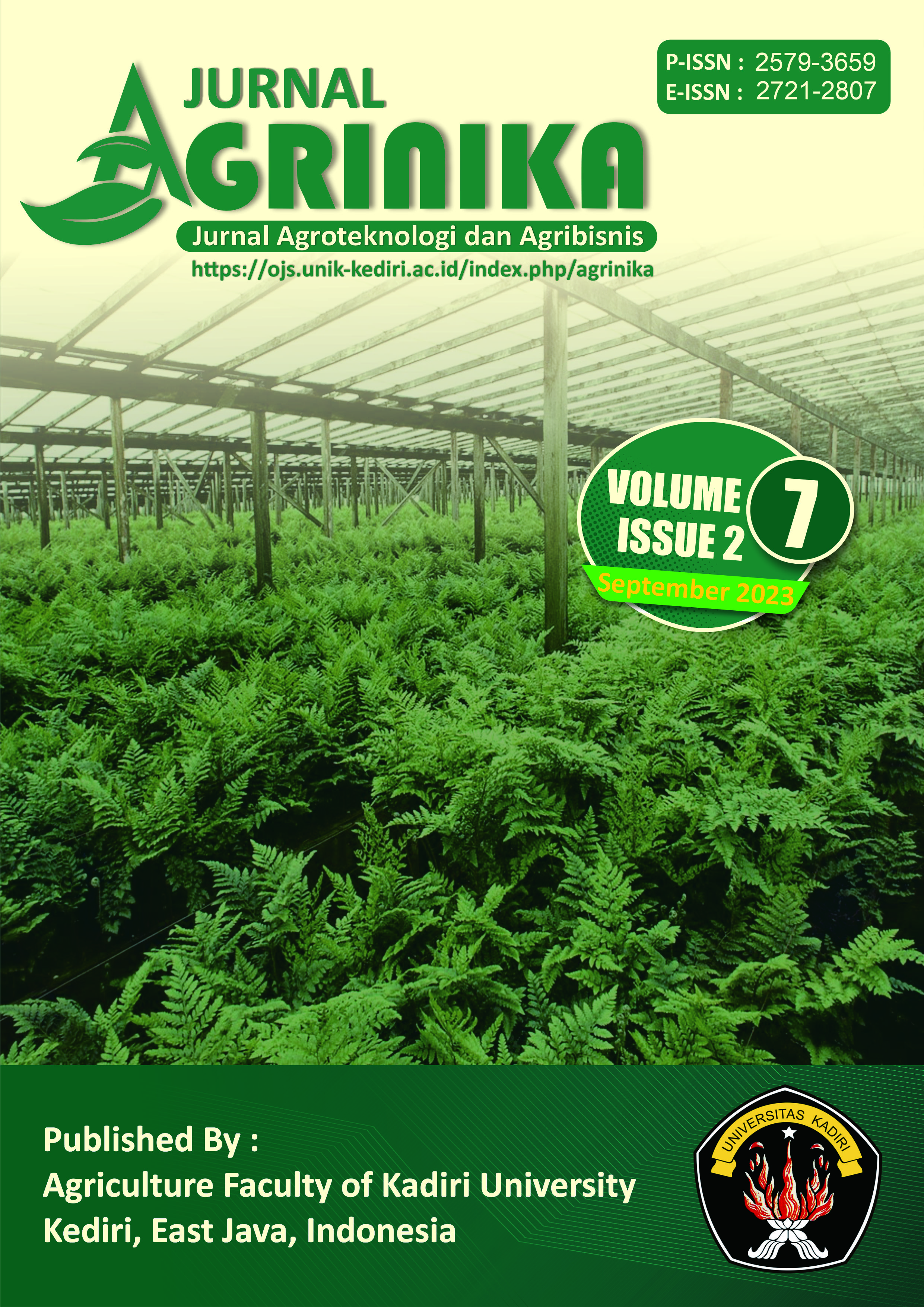Export Competitiveness Analysis of Pepper (Piper Nigrum L) Commodity in the International Market
DOI:
https://doi.org/10.30737/agrinika.v7i2.4773Keywords:
EDP, ISP, Pepper, RCAAbstract
Indonesia is popular as a country relying on the agricultural sector as livelihood and a backbone to support the national economy. One of the current challenges pepper producers encounters is increased competitiveness between producing countries. This increased competitiveness is reflected in the more considerable global pepper production growth than in export growth. This study aims to analyze (1) comparative competitiveness, (2) competitive competitiveness, and (3) trade specialization index. This study used time series secondary data from 2006 to 2020. The study employed an RCA to analyze comparative competitiveness, an EPD to analyze competitive advantage, and an ISP to analyze whether Indonesia tends to be an exporter or importer of pepper commodities. The research results showed that Indonesia, Vietnam, and Brazil are essential in the world pepper trade. The results of the calculation of the RCA index for the 2006-2020 period include that Indonesian, Vietnamese, and Brazilian peppers have a comparative advantage or strong competitiveness in the international market because the RCA value is > 1. Indonesian and Brazilian peppers are in the Rising Star position, indicating that these two countries have a comparative advantage and a competitive advantage. Meanwhile, Vietnam is in a lost opportunity position. The ISP values for Indonesian, Vietnamese, and Brazilian pepper have an average of 0.72, 0.82, and 0.77, respectively. This showed that these three countries have competitive solid capabilities or tend to become pepper-exporting countries.
References
Abdullah, Piter. 2002. “Daya Saing Daerah Konsep dan Pengukuranya Di Indonesia”. Yogyakarta: BPFE-Yogyakarta.
Apridar. 2007. “Ekonomi Internasional: Sejarah, Teori, Konsep dan Permasalahan, Alam Aplikasinya. Jakarta: Unimal Press
Aprilia R., Feira, Zainul Arifin, and Sunarti. 2015. “Indonesia Dalam Menghadapi Globalisasi (Studi Pada Ekspor Lada Indonesia Tahun 2009-2013 ).” Jurnal Administrasi Bisnis (JAB) 27(2):1–7.
Ariesha, Yurike, Zulkifli Alamsyah, and Adlaida Malik. 2019. “Analisis Komparasi Daya Saing Ekspor Lada Indonesia Terhadap Vietnam Dan Malaysia Di Pasar Asean.” Jiseb 22(1):80–90.
Asrol, and Heriyanto. 2017. “Daya Saing Ekspor Pala Indonesia Di Pasar Internasional Indonesia’s Most Export Competitiveness In The International Market.” Jurnal Dinamika Pertanian XXXIII(2):179–88.
Bustami, B., and P. Hidayat. 2013. “Analisis Daya Saing Produk Ekspor Provinsi Sumatera Utara (Competitiveness Analysis on Export Product in Northern Sumatera).” Jurnal Ekonomi Dan Keuangan 1(2):58–71.
Kurnianto, Dini Tri. 2014. “Daya Saing Komoditas Lada Indonesia Di Pasar Internasional (Studi Tentang Ekspor Lada Indonesia Tahun 2010-2014 ).” 40(2):58–64.
Patone, Carina D., Robby J. Kumaat, and Dennij Mandeij. 2020. “Analisis Daya Saing Ekspor Sawit Indonesia Ke Negara Tujuan Ekspor Tiongkok Dan India.” Jurnal Berkah Ilmiah Efisiensi 20(3):22–32.
Prasetyo A, Hotnier Sipahutar, Asrori Asrori, Gunawan Gunawan, Deden Nuryadin, and Catur Budi. 2020. “Komparasi Proses Inovasi Dalam Perspektif Kebijakan Pemerintah Daerah Dan Daya Saing Daerah.” Jurnal REP (Riset Ekonomi Pembangunan) 5(1):47–59. doi: 10.31002/rep.v5i1.2050.
Simangunsong, Bintang C. H., Rizka Awulandari, and Dramaga Bogor. 2016. “Analisis Daya Saing Produk Pulp Dan Kertas Indonesia Di Pasar Dunia ( Competitiveness Analysis of Indonesia ’ s Pulp and Paper Products in a Global Market ).” Jurnal Ilmu Teknologi Kayu Tropis 14(1):87–101.
Viana, C.D.Noor., Ali Hasyim A.R., Adhi.S.P. 2020. "Analisis DayaSaing Komoditas Kopi di Kecamatan Grabag, Kabupaten Magelang". Jurnal Riset Ekonomi Pembangunan. Vol.5 No. 1 Hal: 14-24.
Zuhdi, Fadhlan, and Departemen Agribisnis. 2016. “Analisis Daya Saing Ekspor Kopi Indonesia Dan Vietnam Di Pasar Asean 5 Competitiveness Analysis of Indonesian and Vietnam Coffee Export in Asean 5 Market.” Habitat 26(3):152–62.
Downloads
Published
Issue
Section
License
Copyright (c) 2023 Gustrinazul, Syaiful Hadi , Fajar Restuhadi , Zulkifli, Putri lukmanasari

This work is licensed under a Creative Commons Attribution-NonCommercial-NoDerivatives 4.0 International License.
Authors who publish in this journal agree to the following terms:
- Authors retain copyright with the work simultaneously licensed under a Creative Commons Attribution License (https://creativecommons.org/licenses/by-nc-nd/4.0/) that allows others to share the work with an acknowledgement of the work's authorship and initial publication in this journal. Permitted third-party reuse is defined by the Creative Commons Attribution-NonCommercial-NoDerivs (CC BY-NC-ND). This permission allows users to copy and distribute the Article, provided this is not done for commercial purposes and further does not permit distribution of the Article if it is changed or edited in any way, and provided the user gives appropriate credit (with a link to the formal publication through the relevant DOI), provides a link to the license, and that the licensor is not represented as endorsing the use made of the work.
- Authors are able to enter into separate, additional contractual arrangements for the non-exclusive distribution of the journal's published version of the work (e.g., post it to an institutional repository or publish it in a book), with an acknowledgement of its initial publication in this journal.
- Authors are permitted and encouraged to post their work online (e.g., in institutional repositories or on their website) prior to and during the submission process, as it can lead to productive exchanges, as well as earlier and greater citation of published work.








